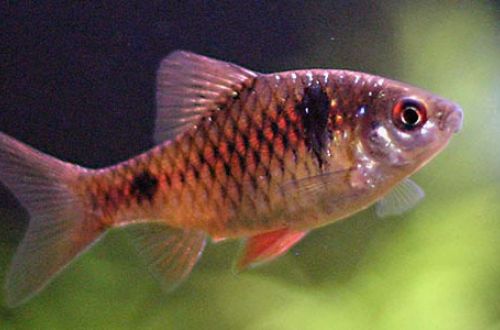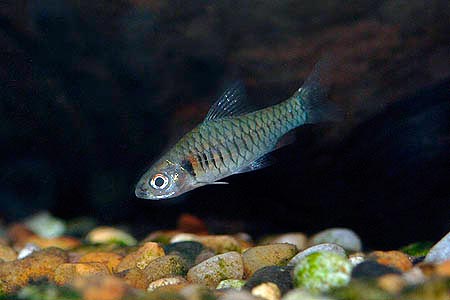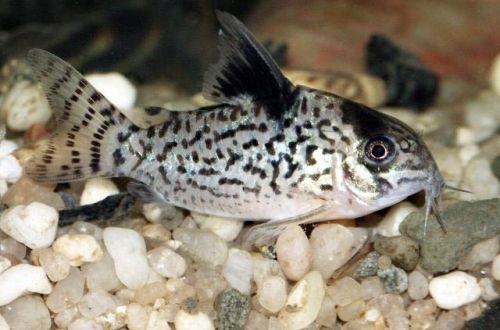
Barbus Tikto
Barbus Tikto, scientific name Pethia ticto, belongs to the Cyprinidae family. Beautiful and unpretentious fish, easy to keep. It has a peaceful disposition and is compatible with many species, making it an excellent candidate for a home community aquarium. It can be recommended even to novice aquarists.

Contents
Habitat
It is widely distributed throughout the Hindustan Peninsula, which is in the southern part of Asia on the territory of such modern states as India, Pakistan, Nepal, Bangladesh, Bhutan and Sri Lanka. Occurs in shallow streams and tributaries of small rivers with dense vegetation and muddy bottoms, sometimes at high altitudes in mountainous areas.
Description
Adults rarely exceed 6 cm in length. Males look slimmer and have a red-orange or pinkish gamut. Females are painted more modestly – in silver color, hints of pink shades are present only on the dorsal panic. A common feature for both sexes is the body pattern, consisting of several dark marks, the first is located behind the head closer to the gill cover, the second encircles the caudal peduncle.
Food
In nature, they feed on worms, insects and other small invertebrates, as well as plants and organic debris. The aquarium will accept all types of high-quality dry and freeze-dried food, live and frozen foods with herbal supplements. A prerequisite for a balanced diet is a combination of all types of feed, a monotonous diet will lead to a weakening of the color and immunity of the fish.
Feed 2-3 times a day in the amount eaten in 5 minutes, all uneaten leftovers should be removed to prevent unnecessary contamination of the water.
Maintenance and care, arrangement of the aquarium
It is advisable to keep a school of fish of 8–10 individuals in a tank of at least 80 liters in order to prevent overpopulation. The design does not play a special role, the fish are not at all whimsical in this regard, so the aquarium can be arranged to your taste. However, experienced aquarists prefer to decorate the tank in accordance with the natural habitat of this species, it is in their favor to say that Tikto Barbs in such conditions show more natural behavior and significantly brighter colors. In this case, the design elements may look like this: a dark substrate, several groups of plants along the side walls, snags or tree branch roots in the center of the composition.
The set of equipment is standard: a filter, an aerator, a heater and a low power lighting system, since the fish do not like excess light. The water parameters are set to neutral or slightly acidic pH values with low hardness. More about pH and dGH parameters in the section “Hydrochemical composition of water”. The allowable temperature is between 18–25°C. If you plan to breed, then the temperature regime should be changed depending on the season, so in the winter months it is necessary to adhere to the lower permissible values uXNUMXbuXNUMXband gradually increase by spring.
Aquarium maintenance comes down to weekly replacement of part of the water (15–20%) with fresh water and periodic cleaning of the soil with a siphon from organic waste and waste products.
Behavior and Compatibility
A peaceful, friendly fish perfectly fits into a community of species similar in temperament and size. The content is schooling, it is recommended to purchase a mixed group of both sexes. In competition for female attention and position in the hierarchy, males display their best colors.
Breeding / breeding
Getting offspring in the general aquarium is quite possible, but due to the lack of parental care in Barbus Tikto and the tendency to eat its own eggs, the survival rate of fry will be at an extremely low level. To increase the chances and make spawning more systematic, you should use a separate tank – a spawning aquarium. In addition, it is necessary to observe the recommended temperature regime described above, in this case, spawning will occur in the spring with the start of an increase in temperature. Also important during this period is the increased feeding of fish with live or frozen food.
A spawning aquarium is usually about 30 liters in size, filled with water from the main aquarium, equipped with a simple sponge filter, a heater and a low power lamp, use floating plants for additional light diffusion. The main attention is paid to the substrate, it is made of balls with a diameter of 1 cm or ordinary soil, but covered on top with a fine mesh of such a size that the eggs slip through it. Such a design will protect the eggs from their parents and safely spawn.
Subject to the temperature regime and diet, the mating season should begin in the first spring months, during this period the males will begin to fight for the attention of the females, and they, in turn, will noticeably round off from the eggs. At this point, the females and the brightest and largest males are placed in a spawning aquarium with identical water conditions. At the end of the process, the fish are returned back.
The fry appear after 24–48 hours, and a day later they begin to swim freely around the aquarium. Feed with specialized microfood, which can be found in professional pet stores in your city.
Fish diseases
Various diseases are not a problem in a balanced aquarium with suitable conditions. Difficulties begin with the deterioration of water quality, poor nutrition, constant stress in fish, etc. Therefore, diseases are only a consequence of an unsatisfactory state of the environment, and this must first be dealt with. However, it is also useful to know the methods of treatment and symptoms of common diseases, more about them in the section “Diseases of aquarium fish”.





